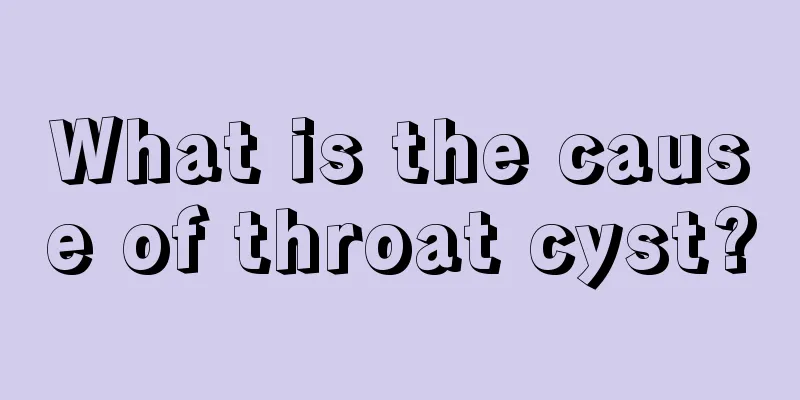What is the cause of throat cyst?

|
We need to pay attention to the formation of laryngeal cysts, especially when these diseases occur in infants and young children, the harm caused is greater. Common congenital laryngeal air cysts, or problems such as obstruction of respiratory secretions, can cause laryngeal cysts, so we should pay more attention to treatment and conditioning. 1. Laryngeal cyst Laryngeal pneumatocele, also known as laryngeal sac, laryngeal diverticulum or laryngeal pneumatic hernia, is an abnormal expansion of the small sac in the laryngeal ventricle, containing gas. The laryngeal sacs in infants and young children are relatively large, generally 6 to 8 mm, and a few can be as large as 10 to 15 mm. When the cyst becomes very large, it is called congenital laryngeal air cyst. The formation of laryngeal air cysts in adults is mostly due to congenital abnormalities of the laryngeal sac, combined with chronic coughing, trumpeting, weightlifting, and laryngeal tumors, which increase the pressure in the laryngeal sac and cause it to expand. According to the location of the air cyst, it can be divided into three types: intralaryngeal, extralaryngeal, and mixed intralaryngeal and extralaryngeal types. 2. The air cyst located in the larynx is the intralaryngeal type. There are two types of this type. One protrudes from the laryngeal ventricle, pushing the laryngeal ventricular band upward, covering the ipsilateral vocal cord, and even extending to the opposite side, obstructing the glottis; the other protrudes from the aryepiglottic fold, deforming the ipsilateral larynx, and some even extend upward to the root of the tongue, located in the epiglottic valley. Air cysts that appear in the neck are called extralaryngeal type. This type of disease often pierces through the superior laryngeal nerve and blood vessels of the thyrohyoid membrane and is located at the anterior edge of the sternocleidomastoid muscle under the hyoid bone; some also pierce through the cricothyroid membrane and are located below the thyroid cartilage. The mixed type is characterized by air cysts that appear simultaneously in the larynx and the neck, connected by an isthmus at the thyrohyoid membrane. There are usually no symptoms at first, but symptoms appear when the tumor grows to a considerable size. 3. The most common symptoms of intralaryngeal cysts are voice changes, unclear pronunciation, hoarseness or silence, often accompanied by cough. Some patients burp before speaking to use the contraction of the pharyngeal muscles to expel the gas in the cyst. People with enlarged air sacs may experience hoarseness and difficulty breathing. If the cyst becomes infected, there will be pain, tenderness in the throat, and foul breath. If secretions enter the throat, it may cause severe coughing. 4. The main external symptoms of the larynx are a round protrusion on the neck, which is sometimes larger and sometimes smaller and is very soft to the touch. It can gradually shrink by squeezing it with the hand and a sound of deflation can be heard. The skin color is normal, with no adhesion or tenderness, but if there is an infection, there will be local redness, swelling and tenderness. The mixed type has symptoms of both types. |
<<: What are the effects and functions of moxibustion of licorice
>>: What are the symptoms of throat cyst
Recommend
Can bitter herb roots be eaten? What are the benefits of drinking soaked water?
There are many types of dandelions, and the whole...
There is a small pimple on the eye socket
The appearance of small bumps on the eye sockets ...
What to do if cooking in an iron pan sticks to the pan
When we cook, we often encounter this situation, ...
Surgical treatment of early gastric cancer
Surgical treatment of early gastric cancer includ...
3 dietary treatments for lymph node enlargement caused by lymphoma
Painless lymphadenopathy throughout the body is o...
How harmful is it to work in a battery factory?
Based on an analysis of your primary complaint, y...
How to care for vitiligo? Four aspects should be paid attention to!
Vitiligo is a skin disease that can occur in any ...
What should I do if my nose is very dry, I have a lot of mucus and nosebleeds?
The nose is the main organ used by our body for b...
Does medical abortion hurt the stomach?
Many medicines can cause harm to the stomach when...
What are the itchy red bumps
If a person's body develops patches of red bu...
The cause of skin fibroma is
The causes of skin fibroma include genetics, envi...
Bladder wall thickness
The bladder is a very important organ in the huma...
Treatment of several special types of lymphoma
Treatments for specific types of lymphoma include...
How long can you live if colon cancer recurs after surgery
The scary thing about cancer is not only the inte...
What are the main causes of kidney cancer?
There are many causes of kidney cancer, so we sho...









